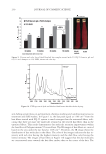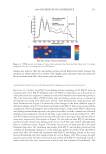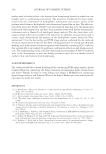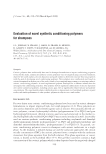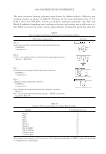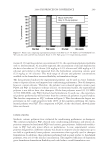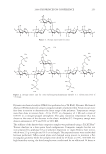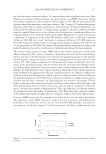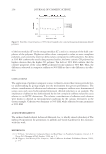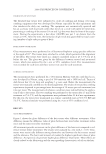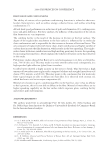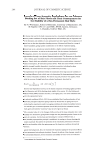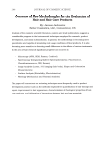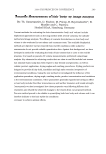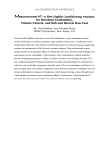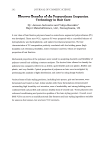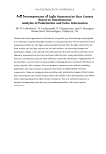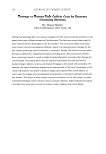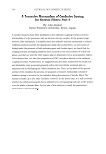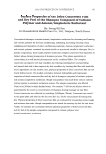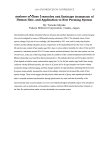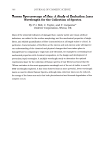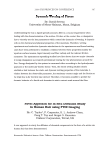2008 TRI/PRINCETON CONFERENCE 241 in 1999, more than doubling in ten years. This total does not include cationic polymers and blends that do not have “polyquaternium” in the INCI name. Most of these polymers are synthetic derivatives. The large number of polymers is a refl ection of the wide variety of monomers available and the numerous combinations that can be synthesized and vari- ables that can be changed within a polymer family (e.g. molecular weight, charge density, monomer ratios, hydrophobic substitution, etc) (3,10,11). Several cationic polymers, par- ticularly those that contain polyvinyl pyrrolidone, are designed for styling while others are designed for conditioning properties and still others for a combination of properties. In this study, about one hundred polymers were synthesized in an effort to develop struc- ture function relationships of synthetic cationic polymers as conditioning agents. Variables such as monomer content and ratios, molecular weight and charge density were evalu- ated. In addition, an experimental cationic polymer designed for a different industrial application was found to have signifi cantly improved deposition characteristics compared with current commercial polymers. EXPERIMENTAL MATERIALS All materials were used as received: Cationic polymers. PQ10 was from Amerchol Corporation (Piscataway, NJ). Experimental synthetic polymers were synthesized by Dow Wolff Cellulosics and The Dow Chemical Company to specifi cations. Commercial synthetic polymers were obtained from Nalco (Tarrytown, NY), BASF (Florham Park, NJ), Rhodia (Cranbury, NJ), and CIBA (Tarry- town, NY). Surfactants. Sodium laureth sulfate, SLES-2, cocoamidopropyl betaine, CAPB, disodium cocamphodiacetate, and DSCADA were all from Cognis (Cincinnati, OH). Silicone. Silicone emulsion (particle size ~200 nm) was from Dow Corning (Midland, MI) Hair. Hair was from International Hair Importers and Products (White Plains, NY). METHODS Wet combing. Wet combing was measured using a Dia-Stron Miniature Tensile Tester. The force required to pull a comb through a wet hair tress treated with surfactant alone and then surfactant plus polymer was measured. Five grams of hair was washed with 0.5 grams of a shampoo, and rinsed at constant temperature. The difference in force required to comb the hair tress before and after treatment was reported as the wet comb reduction. Coacervate study. Haze measurements were performed using a hazemeter two minutes after diluting the test formulation 2.5 to 20 times with water and mixing at room temperature. Silicone deposition. The amount of silicone deposited on hair after shampooing was mea- sured. Five grams of hair was washed with 1 gram of a shampoo, and rinsed at constant temperature. Hair was extracted with a 1:1 mixture of methyl butyl ketone and toluene. Atomic absorption spectroscopy was used to measure silicone content reporting μg silicone/g hair.
JOURNAL OF COSMETIC SCIENCE 242 Panel studies. Five grams European brown hair was washed with 1 gram of shampoo (sam- ple A) with the test product while fi ve grams of hair was washed with 1 gram of a control shampoo (sample B). For each panel study, two tresses of hair were washed with sample A and two tresses were washed with sample B. One tress of each sample (A and B) was hung side by side in two sets of two. Panelists were asked to compare each set separately for feel and ease of comb wet in a forced choice test. Five panelists were asked to do the evaluation, giving a total of 10 evaluations. The test was repeated on separate hair tresses prepared as described and then dried. Panelists were asked to compare each set for dry feel and comb. Polymer substantivity. Each tress was wetted and washed with 1 g of shampoo for 1 minute and rinsed with tap water. The tress was rewashed as needed for the dye build up test. After the completion of the washes, the tress was placed in a beaker with 50 mL of 0.05% red dye 80 (Jos. H. Lowenstein Sons, Inc., Brooklyn, NY) in deionized water (pH 3.0) for one minute (gently shaken). The tress was removed and rinsed under tap water to remove unattached dye. Excess water was squeezed from the tress and the hair was placed in a beaker containing 50 ml isopropanol/water (50/50 by volume) solution (pH=12.5) for 5 minutes with occasional gentle shaking. Hair was removed from the solution, rinsed, dried, and weighed. Absorbance of the extraction solution was measured at 533 nm and the amount of dye calculated using a calibration curve for dye concentration and equation 1: μg dye/g hair = (abs + 0.0013) * (5 × 104) / (wt of hair, g) (1) RESULTS AND DISCUSSION EVALUATION OF COMMERCIAL SYNTHETIC POLYMERS Several commercial synthetic polymers were evaluated for coacervate formation, objective wet comb and silicone deposition. The study included 11 commercial polymers (Table I). Not all polymers were tested for each performance characteristic. Coacervate studies were performed as a screen to determine if the polymer phase separates from the formulation on dilution and was performed on all samples. Wet combing is a good measure of overall conditioning on damaged hair and was used to screen six of the polymers. Only two poly- mers were screened for silicone deposition. In all cases, cationic guar and PQ10 polymers were used as positive controls for these studies. Figure 2 shows the coacervate curves of 0.5% polymer in 15.5% sodium laureth sulfate-2 (SLES-2) & 2.6% disodium cocoamphodiacetate (DSCADA). Several of the polymers, including Blend A, Blend B, and PQ47 did not form coacervates. Others, such as PQ11, had variable results depending on the manufacturer. Some were not compatible with the formulation, in which case coacervates could not be detected. These differences may be related to the molecular weight, residual monomer levels or cationic substitution of the polymer. For the samples that did form coacervates, they tended to form early in the dilu- tion process, similar to one PQ10 (high molecular weight/high charge density, Amerchol Corp.) and cationic guar (Rhodia). In contrast, the second PQ10 (high molecular weight/ medium charge density, Amerchol Corp.), formed coacervate at later dilution. It has been shown that this later coacervate, which forms at higher dilution, tends to lead to softer conditioning properties (1,4).
Purchased for the exclusive use of nofirst nolast (unknown) From: SCC Media Library & Resource Center (library.scconline.org)









































































































































